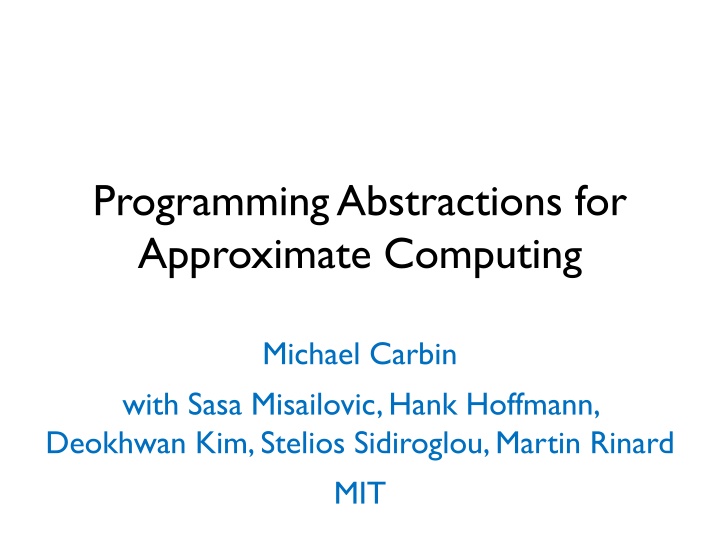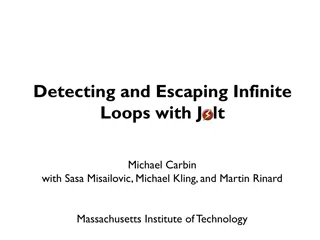
Exploring Programming Abstractions for Approximate Computing Challenges
Delve into the world of approximate computing with insights from "Programming Abstractions for Approximate Computing" by Michael Carbin and team. Discover the challenges of specifying approximations, verifying program results, reproducing failures, and adapting to changing assumptions. Learn fundamental questions on approximation scope, correctness specifications, and reasoning. Explore approximation transformations, examples like loop perforation, and approaches such as approximate hardware and code perforation.
Download Presentation

Please find below an Image/Link to download the presentation.
The content on the website is provided AS IS for your information and personal use only. It may not be sold, licensed, or shared on other websites without obtaining consent from the author. If you encounter any issues during the download, it is possible that the publisher has removed the file from their server.
You are allowed to download the files provided on this website for personal or commercial use, subject to the condition that they are used lawfully. All files are the property of their respective owners.
The content on the website is provided AS IS for your information and personal use only. It may not be sold, licensed, or shared on other websites without obtaining consent from the author.
E N D
Presentation Transcript
Programming Abstractions for Approximate Computing Michael Carbin with Sasa Misailovic, Hank Hoffmann, Deokhwan Kim, Stelios Sidiroglou, Martin Rinard MIT
Challenges for Programming Expression (specifying approximations) Reasoning (verifying resulting program) Debugging (reproducing failures) Deployment (changes in assumptions)
Challenges for Programming Expression (specifying approximations) Reasoning (verifying resulting program) Debugging (reproducing failures) Deployment (changes in assumptions)
Fundamental Questions Scope What do we approximate and how? Specifications of Correctness What is correctness? Reasoning How do we reason about correctness?
[Misailovic, Carbin, Achour, Qi, Rinard MIT-TR 14] What do we approximate? Domains have inherent uncertainty Benchmark Domain LOC LOC (Kernel) Time in Kernel (%) 23 sor blackscholes dct idct scale numerical finance 173 494 532 532 218 82.30% 65.11% 99.20% 98.86% 93.43% 88 62 93 88 image processing Execution time dominated by a fraction of code
Approximation Transformations Approximate Hardware PCMOS, Palem et al. 2005; Narayanan et al., DATE 10; Liu et al. ASPLOS 11; Sampson et al, PLDI 11; Esmaeilzadeh et al. , ASPLOS 12, MICRO 12 Function Substitution Hoffman et al., APLOS 11; Ansel et al., CGO 11; Zhu et al., POPL 12 Approximate Memoization Alvarez et al., IEEE TOC 05; Chaudhuri et al., FSE 12; Samadi et al., ASPLOS 14 Relaxed Synchronization (Lock Elision) Renganarayana et al., RACES 12; Rinard, HotPar 13; Misailovic, et al., RACES 12 Code Perforation Rinard, ICS 06; Baek et al., PLDI 10; Misailovic et al., ICSE 10; Sidiroglou et al., FSE 11; Misailovic et al., SAS 11; Zhu et al., POPL 12; Carbin et al. PEPM 13;
Example: Loop Perforation float sum = 0; for (int i = 0; i < n; i += 1) { sum = sum + a[i]; } float avg = sum / n;
Example: Loop Perforation float sum = 0; for (int i = 0; i < n; i += 1) { sum = sum + a[i]; } float avg = sum / n; float avg = (sum * 2) / n; i += 2 Skip iterations (or truncate or random subset) Potentially add extrapolations to reduce bias
What is correctness? .c .c Traditional Transformation
What is correctness? .c .c Approximate Transformation
What is correctness? Safety: satisfies standard unary assertions (type safety, memory safety, partial functionality) Accuracy: program satisfies relational assertions that constrain difference in results
Relational Assertions Contribution: program logic and verification system that supports verifying relationships between implementations relate |x<o> - x<a>| / x<o> <= .1; x<o>: value of x in original implementation x<a>: value of x in approximate implementation [Carbin, Kim, Misailovic, Rinard PLDI 12, PEPM 13]
Example: Loop Perforation float sum = 0; for (int i = 0; i < n; i += 1) { sum = sum + a[i]; } float avg = sum / n; float avg = (sum * 2) / n; i += 2
Example: Loop Perforation float sum = 0; for (int i = 0; i < n; i += 1) { sum = sum + a[i]; } float avg = sum / n; float avg = (sum * 2) / n; i += 2 b-a 2 Worst-case error:
Novel Safety Verification Concept Assume validity of assertions in original program Use relations to prove that approximation does not change validity of assertions p<o> == p<a> safe(*p<o>) safe(*p<a>) assert (safe(*p)) Lower verification complexity than verifying an assertion outright
Specifications and Reasoning Worst-case (for all inputs) Non-interference [Sampson et al., PLDI 11] Assertions [Carbin et al., PLDI 12; PEPM 13] Accuracy [Carbin et al., PLDI 12] Statistical (with some probability) Assertions [Sampson et al., PLDI 14] Reliability [Carbin, Misailovic, and Rinard, OOPSLA 13] Expected Error [Zhu, Misailovic et al., POPL 13] Probabilistic Error Bounds [Misailovic et al., SAS 13]
Question #1: Programmers will never do this. - Unnamed Systems and PL Researchers
Challenge Full Functional Correctness Complexity Partial Specifications Reasoning Types Expressivity
Challenge Full Functional Correctness Complexity Partial Specifications Reasoning Types Expressivity Ordering of unary assertions still true (improved by relational verification)
Challenge Probabilistic Accuracy Bounds Probabilistic Assertions Reliability Worst-case Accuracy Assertions Expected Error Error Distributions Complexity Reasoning Expressivity Performance/Energy Benefit
Example: Loop Perforation (Misailovic et al., SAS 11) float sum = 0; for (int i = 0; i < n; i += 1) { sum = sum + a[i]; } float avg = sum / n; float avg = (sum * 2) / n; i += 2
Example: Loop Perforation (Misailovic et al., SAS 11) float sum = 0; for (int i = 0; i < n; i += 1) { sum = sum + a[i]; } float avg = sum / n; float avg = (sum * 2) / n; i += 2 b-a 2 Worst-case error: 0.6*(b-a) Probabilistic Error Bound (.95): n
Question #2: There s no hope for building approximate hardware. - Unnamed Computer Architect
Challenge Approx. PL community must work with hardware community to collaborate on models (not the PL community s expertise) Approx. hardware community faces major challenge in publishing deep architectural changes: simulation widely panned Moving forward may require large joint effort
Question #3: I believe your techniques are fundamentally flawed. - Unnamed Numerical Analyst
Challenge Numerical analysts have been wronged Programming systems have failed to provide support for making the statements they desire Approximate computing community risks repeating work done by numerical analysis Opportunity for collaboration New research opportunities It s no longer just about floating-point
Broadly Accessible Motivations Programming with uncertainty (uncertain operations and data) Programming unrealizable computation (large scale numerical simulations) Useful computation from non-digital fabrics (analog, quantum, biological, and human) Opportunity to build reliable and resilient computing systems built upon anything
Conclusion Adoption hinges on tradeoff between expressivity, complexity and benefit Opportunity/necessity for tighter integration of PL and hardware communities
Open Challenges and Directions Probabilistic Accuracy Bounds Complexity Worst-case Accuracy Reasoning Probabilistic Assertions Reliability Error Distributions Expected Accuracy Expressivity Problem: benefits (performance/energy) may vary between different types of guarantees
Open Challenges and Directions Expressivity and Reasoning Complexity Type Checking Partial Specifications Full Functional Correctness
Experimental Results Benchmark LOC LOC (Kernel) Time in Kernel (%) 173 sor blackscholes dct idct scale 23 88 62 93 88 82.30% 65.11% 99.20% 98.86% 93.43% 494 532 532 218
Open Challenges Directions Traditional Tradeoff Dynamic Analysis Type Checking Partial Specifications Full Functional Correctness Performance/Energy Reasoning Complexity

